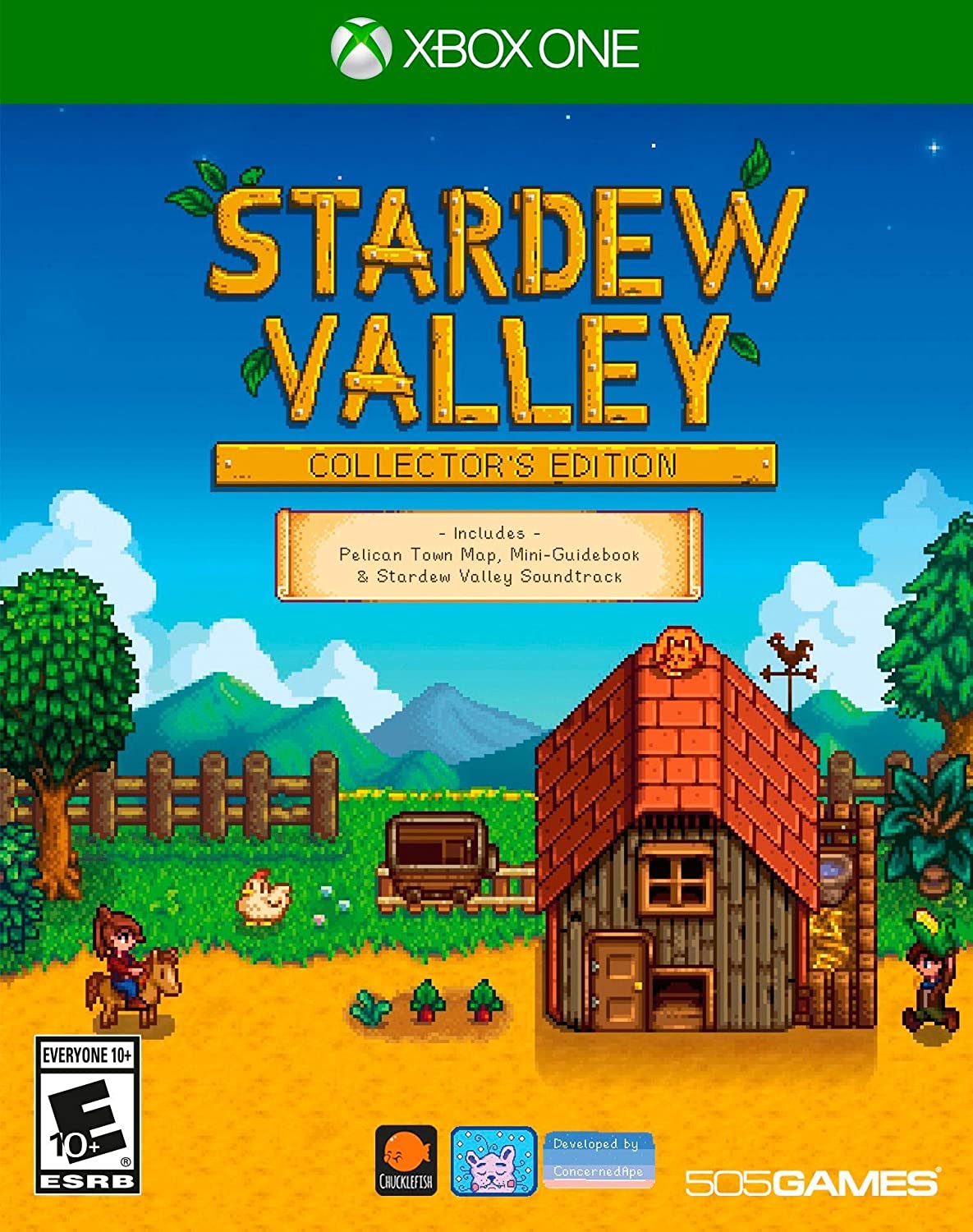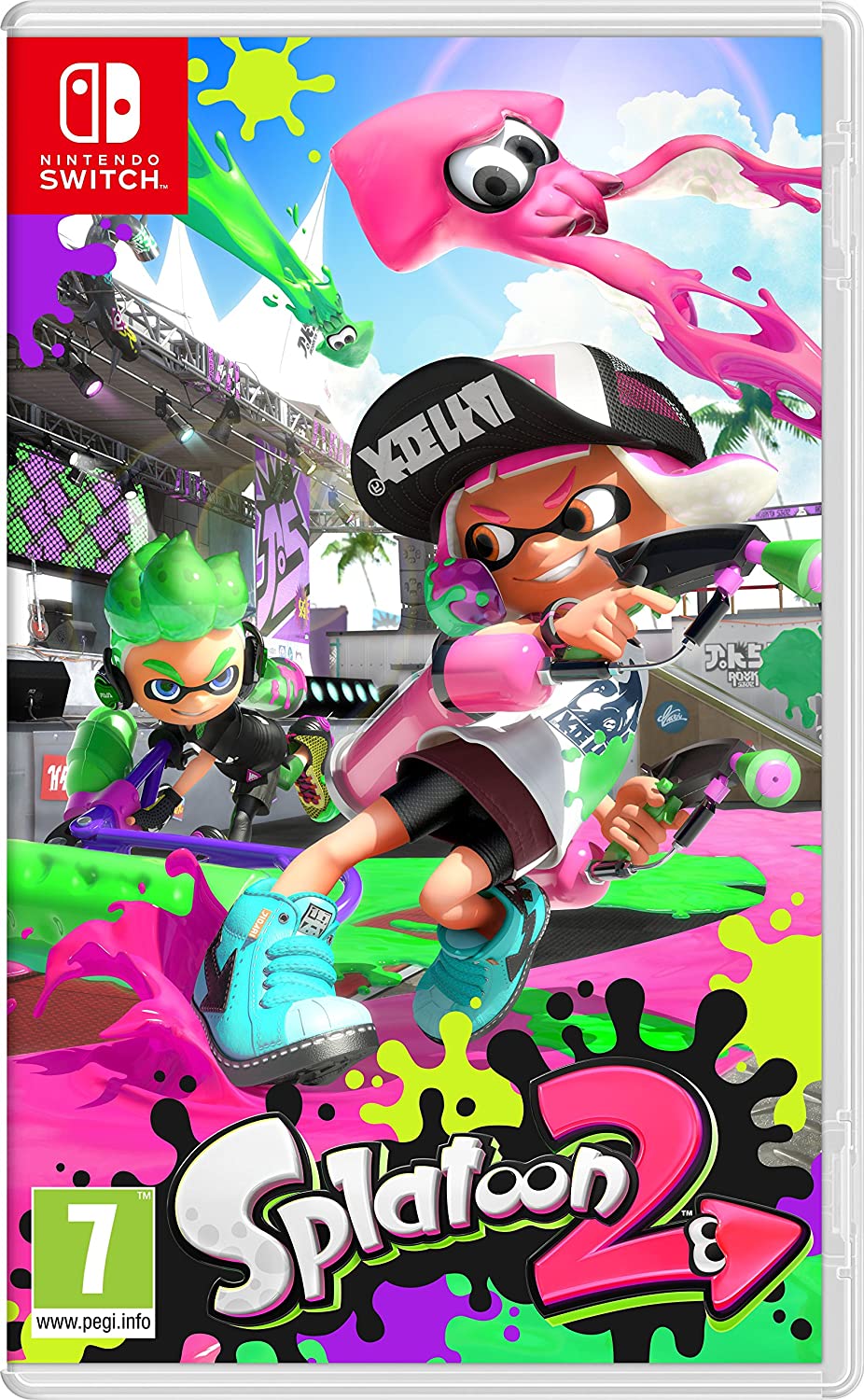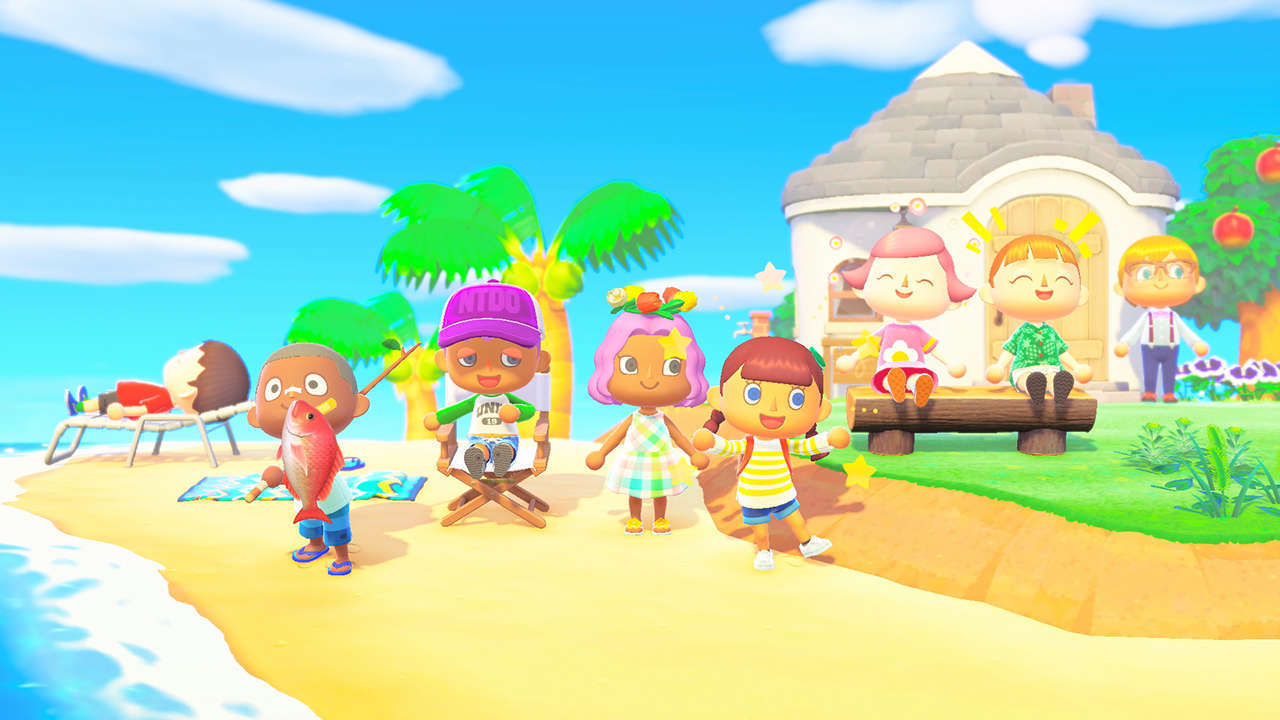Stardew Valley
Several big content updates grow Stardew Valley into an even more delightful, robust farming RPG.
Each time I start up a new farm in Stardew Valley or return to my 100-hour save on PC, I feel like I’m going home. There’s a comfort in Stardew Valley that I’ve rarely found in other games. The music that changes with each season perfectly fits the mellowness of the 16-bit countryside town, and all the activities that await offer both peace in my daily routines and excitement in the land’s mysteries. Whether you want to farm, fish, fight monsters, craft, mine, become everyone’s best friend, or do a little bit of everything, this farming adventure has plenty to offer.
As we said in our original review, Stardew Valley “beautifully combines farm simulation with RPG elements to create an intriguing, absorbing rural world,” and it’s only gotten better with each massive free update. Multiplayer, new items, buildings, farm types, events, and relationships give Stardew Valley an even better foundation and more of a reason to stick around past the coveted event in the third in-game year.
The five new farm maps offer better focus for players than when Stardew Valley first launched. Each of the farms’ designs encourages different types of work – farming, fishing, foraging, mining, and combat. Each map’s activities are a relief from the grips of Joja Corporation, the cold, in-game company that encroaches on Pelican Town.
Stardew Valley’s story is a simple, yet satisfying one. You inherit your grandfather’s farm after leaving the grind of your job with the Joja Corporation. Once settled on the farm, you then have to decide whether to support the local Joja Mart or rebuild the decaying community center. This conflict is the driving factor in the two or so years that span Stardew Valley’s story, but once that’s all completed, befriending and learning about the townspeople introduce other contained stories.
The residents of Pelican Town and beyond are a charming bunch.
The residents of Pelican Town and beyond are a charming bunch, though improving your relationship with each of them is rather superficial. All you have to do is give them presents they like twice a week to slowly earn their trust and affection. Giving them items they dislike can lower their affection level, so that at least encouraged me to try and figure out what each person enjoys most and to get creative with my gifts once I had some expendable resources well into my second year. That’s right, Maru — you’ve been upgraded to pepper poppers.
Despite the system’s simplicity, it’s still rewarding to learn about each person’s dreams, passions, and challenges living in Stardew Valley. There’s a friendly monster who just wants to sell his merchandise to nice people, an artist who’s a little too shy to share her artwork, a bitter old man who’s hesitant to make connections, a scientist who studies the valley’s wildlife, and plenty other interesting folks.
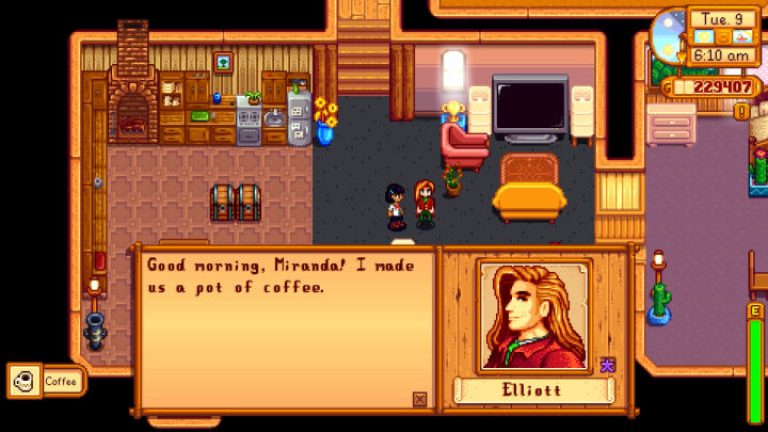
After reaching certain friendship or romance levels, a special character scene plays if you catch them in the right time and place. The 12 romanceable characters have more scenes than others, and if you choose to marry one, they move into your home and actually help around the farm every now and then. It’s a welcome benchmark for the late game. NPCs are also the key to learning certain food recipes and crafting blueprints, so there’s value in befriending them beyond discovering their interests and personal conflicts. They’ll even send a small gift back to you occasionally.
Sprouting Charm
The changing of seasons in Stardew Valley is perhaps one of the most exciting events. Where summer has plenty of sunny days with a few useful thunderstorms here and there – with the right tools, you can make batteries with the lighting! – the snow-covered ground in winter prevents any crops growing outside, leaving the season’s activities a little more up in the air if you’re primarily a farmer. Every season has its own enjoyable pace that comes with the varying weather, crop types, NPC schedules, birthdays, fish, and fun festivals that keep things engaging. Each season runs for 28 days, so figuring out how to best spend them is a great challenge as each in-game year passes. By the time I reached the end of my second year, I felt confident in my daily routine and farming strategies.
Farming isn’t overly complex, but the methodical nature of it is relaxing. It does take a fair bit of time in the first year to make enough money to get a good number of the best seeds, optimize your farmland, implement a watering system, and figure out a routine to take care of it all. Stardew Valley has levels for each main mechanic – farming, fishing, mining, combat, and foraging. Figuring out how to make the most of my days was a great challenge early on when I had a low energy meter for executing actions like chopping wood, tilling soil, and using the watering can, all without extra farming bonuses from my level. But even when that energy meter grew and I earned farming specializations, the difficulty and enjoyment I found in farming came from managing more land and deciding whether or not to process the farmed goods to make them into more profitable artisan goods or do something else with them entirely. For instance, I could sell all my grapes, cook them for my own consumption for energy and health, or I could save them to make jelly or wine with the craftable preserves jar and keg. Adding farm animals to the mix made for even more welcome diversity in my daily farming routine.
Even with the big updates, Stardew Valley still has the mild problem of having so much to do with little explanation for how to do it, but there certainly is a joy to creating your own routines and discovering what works best for how you want to play. The in-game TV show Living off the Land provides good tips on mechanics and seasonal changes, but there’s not a whole lot of help on how to use some of the less straightforward items. For instance, a great new item picks up all products from goats, cows, and sheep, but I had to use a guide to figure out how to actually get it to work. On the other hand, new items like the planter pot make the early game a little easier. It allows the player to grow any plant per pot indoors regardless of the season, making it especially helpful for completing some early important challenges and requests from villagers that are easy to miss once a season ends.
When I wasn’t farming or petting farm animals, I was foraging for the season’s natural goods (which is as simple as walking around and picking them off the ground) or fishing. Stardew Valley tracks everything you’ve had in your collection, so there’s definitely an incentive to try each main activity. Unlike farming, where you need to buy seeds to grow the next thing on the list, there’s a strict schedule to when certain fish are available, and some of them are incredibly difficult to catch. The fishing minigame itself is easygoing fun for the small fries but can be a little frustrating for some of the more rare fish. Still, that challenge is something I’m looking forward to conquering eventually once I craft enough of the right tackles and stock up on bait to lure the rare beasts in.
Stardew Valley really has a thing for collecting, and I’m very into it.
Mining and combat, on the other hand, are a little more straightforward. The main mine has a handful of enemies that progressively get stronger with each of its 100 levels, and an additional cavern in an unlockable area houses even more difficult monsters and a seemingly infinite number of floors. Spelunking through the main cave is a dangerous endeavor early on, but obtaining better weapons and armor through the shop, chests, enemy drops, or through reaching new combat levels make it more manageable. The combat consists of simple button mashing to swing a sword, so pairing monster fights with the challenge of descending into a mine makes it a lot more fun and rewarding. The added difficulty of getting out of the mine before your character passes out at 2:00 a.m. also puts the pressure on for making it through the caves as efficiently as possible. Then, there are challenges from a group called the Adventurer’s Guild to clear a certain number of the more popular monster types, so there’s yet another incentive to descend the mines to slay monsters. Oh, and there’s even more collecting involved as you mine old and strange artifacts that can be donated to the local museum for even more rewards. Stardew Valley really has a thing for collecting, and I’m very into it.
Regardless of their varying complexity, progression through all five skills is constant and rewarding. In addition to that basic fulfillment, just about every skill level has some sort of craftable reward and helps build your proficiency, or lowers the amount of energy required to use a tool. At skill levels five and 10, you get to specialize your character further by choosing professions that give bonus stats to certain actions. For example, a rancher gets more gold from animal products, but tillers sell crops at a higher price. That profession is refined further at level 10. I’m halfway into my third year in Stardew Valley and I still haven’t finished getting all my skills to level 10. Like with real life, there’s potential to do a lot in a day, but how it’s spent is entirely up to you. When you add someone else to your farm, though, those days can be a whole lot more productive.
Ripened Co-Op
Multiplayer is a fantastic addition to Stardew Valley that entirely changes how the game can be played. As expected, it helps you accomplish far more in a day if you have a cooperative farmhand, but does so without feeling too much like a cheat code. When a friend joins they get their own home (that the main player can enter and customize) and have to start a new character from scratch. This means they have low energy, weak starting tools, hardly any crafting recipes, and no skill perks. While it would have been nice to have the option to import a character with all its stats and upgraded tools – maybe even at a cost – starting fresh is the more balanced trade-off for having multiple people on a farm.
You share money with up to three farmhands/friends who can meddle in your belongings, so it’s not entirely too difficult to get new players up to speed if you’re adding them to an established farm. Still, having to support others’ endeavors out of your pocket helps multiplayer maintain that balance between difficulty and power, and you can even change the profit margins for your co-op save if you feel like you’re making too much money. The updates added some incredibly useful but expensive items, so I definitely haven’t complained about making more gold every day. If you’re starting a new farm together, I could see how splitting up each task could make that first challenging year easier to take on, and maybe even more fun. Someone who prefers to fish or mine could focus on that while someone who likes farming could look after the crops.
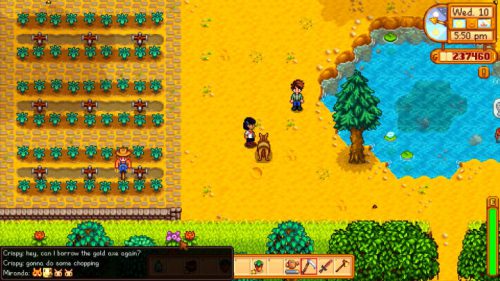
Farmhands have ownership over their cabin and relationships with NPCs in your game, too, which is an important incentive for helping out a friend on their farm since it gives them both a stake in your land and in the rest of your game, too. They can upgrade their home and even get married to your character or an NPC you haven’t romanced. It might be a bit tedious to have to go through the whole courting process again if you’ve already unlocked everything on your primary farm, but I appreciate that it offers a chance to start a new romance with a different character and to essentially establish a new life on a farm that can progress while you’re not there if the primary farmer chooses to play without you.
My friend was incredibly helpful in kicking off the summer farming season as we toiled away for days leading up to it, calculating how many seeds of a specific fruit we’d need. Communication happens through a simple in-game text chat that’s equipped with plenty of great emojis. It ended up being an expensive season because of all the seeds I had to buy, but that investment my friend suggested has definitely paid off. Though his farming suggestions were helpful, spelunking with him was even more fun. Together we slayed plenty of monsters and got further in the challenge cavern than I had before. The easygoing nature of Stardew Valley also creates a wonderfully pleasant space to hang out with friends, which is a nice thing to have when so many multiplayer games are set in rather tense situations.
The Verdict
Stardew Valley is a beautiful, fun game that, when all of its parts are pulled together, make for a wonderful countryside adventure. Whether it’s rainy, sunny, snowy, or dusted with pollen drifts through the air, each day offers an abundance of great activities ready to be collected or mastered and new friendships waiting to be made. Even 100 hours in with three in-game years in the books, I still feel like I have so many mysteries to discover, and plenty of items to collect. New items, goals, and events from all the updates since its launch make Stardew Valley more welcoming for new players and extends its life for seasoned farmers, too. The fantastic multiplayer is just the cherry on top of the cake to this marvelous farming RPG.
This article has been taken from Here.

